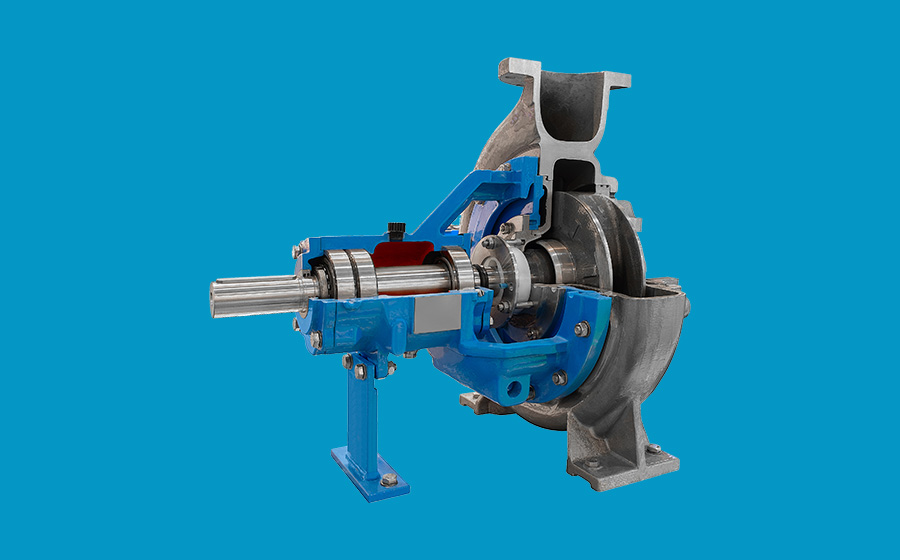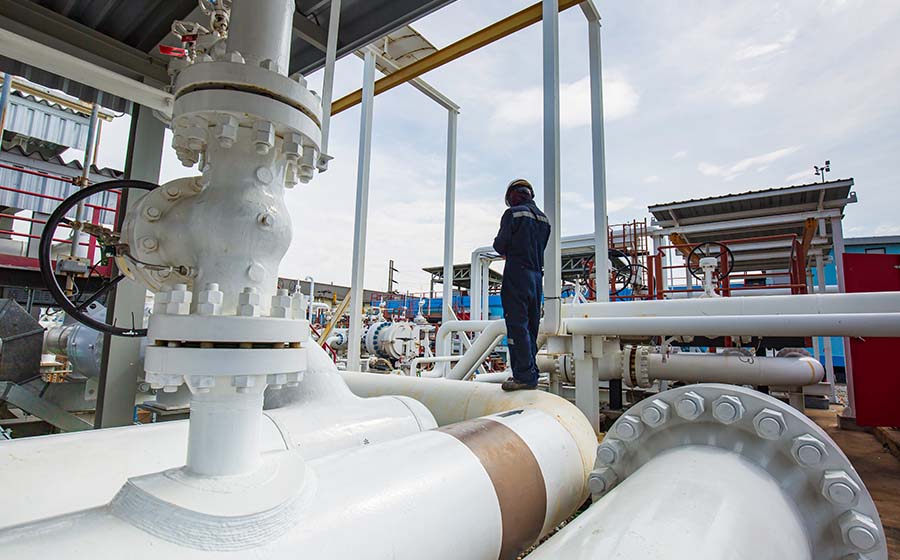
Centrifugal Pumps – Types, Functions & Applications
Centrifugal pumps are the most in-demand pumps sought by multiple industries all over the world. They offer better performance and output due to their simple design and build. They are easy to operate and maintain too.
Centrifugal pumps are extensively used in industrial, agricultural, and home applications to pump water, solvents, organics, oils, acids, bases, and other ‘thin’ liquids. In fact, you can find a centrifugal pump for almost any application that involves low viscosity fluids.
There are orientations, stages, and even impeller designs to consider when classifying centrifugal pumps. The structure, application, design, fluid to be pumped, pressures and temperatures required, compliance, and servicing all play a role in selecting the right pump.
How Does A Centrifugal Pump Work?

A centrifugal pump is a mechanical device that moves a fluid by transferring rotational energy from one or more impellers, or driven rotors. Fluid enters the impeller along its axis and is cast out throughout its circumference by centrifugal force through the impeller’s vane tips. The impeller increases the velocity and pressure of the fluid while also directing it towards the pump output. The pump casing is designed to compress fluid entering the pump, direct it into the impeller, and then control and regulate it before outflow.
One or more impellers are attached to and revolve with the pump shaft in centrifugal pumps. This lends the liquid the energy to go through the pump and pressurize it so it can move through the piping system. As a result, the pump transforms mechanical energy from a motor into fluid energy. Some of the energy is converted to kinetic energy, which is represented by fluid pressure, and some is converted to potential energy, which is represented by raising the fluid against gravity to a greater height.
A centrifugal pump operates by guiding liquid in the system into the pump’s suction port and then into the impeller’s inlet. The liquid is subsequently moved along the spinning vanes by the rotating impeller, which increases the liquid’s velocity energy. The liquid next exits the impeller vanes and enters the pump volute or diffuser casing, where the fluid’s high velocity is converted to high pressure via a diffusion process. The fluid is subsequently sent through the pump’s discharge port and then out into the system, or, in the case of a multi-stage pump, on to the next step.
Centrifugal and Positive Displacement Pumps are the two primary types of pumps. Centrifugal pumps are often designed for larger flows and lower viscosity liquids, down to 0.1 cP. They typically account for 90% of the pumps in certain chemical facilities. Positive displacement pumps, on the other hand, are also preferred in a number of applications.
Different Types Of Centrifugal Pumps
Based on the mechanism driving the operation, centrifugal pumps are classified into 4 primary types:
1. Mechanically Actuated
A reciprocating mechanical linkage is directly linked to the diaphragm in this type of pump. The pump incorporates a gear set or other mechanical device that converts the motor’s spin into a reciprocating motion of the diaphragm’s linkage. The stroke length or pump speed can be changed to alter the flow.
2. Hydraulically Actuated
An intermediate hydraulic fluid positioned on the non-product side of the diaphragm is used to flex the diaphragm in this type of operation. A reciprocating plunger pressurizes the hydraulic fluid. The plunger is not linked to the diaphragm and instead pressurizes the intermediate hydraulic fluid, which flexes the diaphragm, similar to a mechanically operated diaphragm. With this sort of diaphragm pump, flow can be adjusted by changing the pump speed or the volume of hydraulic fluid bypassed.
3. Solenoid
An electric motor alternates energizing and de-energizing a solenoid, providing an electro-magnetic force that reacts with a metal component on the diaphragm in these pumps. The diaphragm flexes as a result of this. The pump speed is changed to change the flow.
4. Air Operated Double Diaphragm Pumps (AODD)
This is a double-acting pump of a sort. They have two check valves and two diaphragms. Compressed air is used to power the pump, which operates on the non-product side of one diaphragm and then the other. A shuttle valve distributes air to the diaphragm’s opposite sides. The air pressure supplied to the pump is changed to change the flow.
There are other classifications of Centrifugal pumps too.
1. Based on Orientation
- Radial Centrifugal Pumps
- Axial Centrifugal Pumps
2. Based on Stages
- Single Stage
- Two Stage
- Multiple Stage
3. Based on Impeller Type
- Single Suction
- Double Suction
- Vortex Open
- Open Impeller
- Semi-Closed Impeller
- Closed Impeller
Each pump serves a unique purpose and are used as a standalone component, or as a part of a huge plant.
Centrifugal Pumps - Applications & Industries
Centrifugal pumps are used very commonly in most industries and agricultural operations. They are used to pump any lower viscosity liquid through a single stage or multiple stage setups.
| Pump Type | Features | Applications |
|---|---|---|
| Diaphragm Type Pumps | Sealless Allows for metering of fluids Suitable for high pressure processes | Commonly used as metering pumps to pump precise volumes of liquid for treating water. Eg., drinking water, waste water, boiler water, swimming pool water, etc. |
| Chopper/grinder pump | Impeller designed with grinding teeth to chop solids | Waste water in industrial, chemical and food processing, & Sewage treatment |
| Circulator pump | Inline compact design | Heating, ventilation and air conditioning |
| Multistage pump | Fitted with multiple impellers for increased discharge pressures | High pressure applications |
| Cryogenic pump | Constructed with special materials that can tolerate low temperatures | Liquid natural gas, coolants |
| Trash pump | Designed to pump water containing solid debris | Draining mines, pits, construction sites |
| Slurry pump | Designed to handle and withstand highly abrasive slurries | Mining, mineral processing, industrial slurries |
| Magnetic drive pump | Sealless; impeller driven by close coupled magnets | Hydrocarbons, chemicals where no leakage is permitted |
Advantages Of Using Centrifugal Pumps In Your Operations
i. Since there are no drive seals, the risk of leakage is completely eliminated. As a result, dangerous liquids can be pumped without spilling. By removing the drive seals, leaks, friction loss, wear, and noise are eliminated, and the fluid is completely separated from the pump drive. This ensures that virtually all of the motor’s energy is turned into pumping energy.
ii. There is no heat transmission from the motor since the pump chamber and the motor are separated by an air gap, which acts as a thermal barrier.
iii. Liquid cannot seep into the motor from the pump due to complete separation from the process media.
iv. Friction is greatly reduced.
v. If the pump’s load is too high, the magnetic coupling can break. This ensures that the pump doesn’t get overloaded and prevents damage.
Some Limitations Of Centrifugal Pumps
i. When using a magnetic drive pump, liquids containing ferrous particles can be problematic. This is due to particles accumulating on the impeller magnet, causing the pump to stop operating over time.
ii. Coupling results in some energy wastage, owing to certain magnetic resistance. In a few instances, the coupling may slip unexpectedly due to heavy loads.
Some common mishaps encountered by these pumps are listed here:
- Cavitation occurs when the system’s net positive suction head is too low for the pump used.
- Excessive impeller wear, which is frequently exacerbated by suspended particles.
- Corrosion produced by the fluid characteristics inside the pump.
- In the line, there is a surge or back surge.
- Low flow causes the pump to overheat.
- The media is leaking along the rotating shaft.
- Lack of prime—in order to work, centrifugal pumps must be filled (with the fluid to be pumped).
Summary
Centrifugal pumps are used in most low pressure, high capacity pumping applications involving low viscosity fluids such as water, solvents, chemicals, and light oils. Water supply and circulation, irrigation, and chemical transfer in petrochemical facilities are examples of typical applications. Positive displacement pumps are favored for applications requiring high viscous fluids like thick oils and slurries, especially at high pressures, for complicated feeds like emulsions, edibles, or biological fluids, and when precise dosing is required.
Centrifugal pumps are an ideal choice for applications in various industries as they are easy to design and create, and are cost-effective too.
Check out the wide range of high quality pumps and other industrial supplies from the leading procurement and supply partner, EuroIndustriel. Call us or drop us an email to understand how we can help you improve your processes with the best in class industrial equipment & supplies.
















